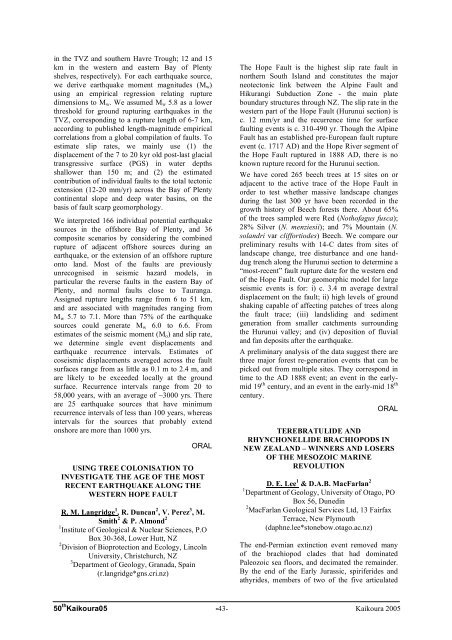50thKaikoura05 -1- Kaikoura 2005 CHARACTERISATION OF NEW ...
50thKaikoura05 -1- Kaikoura 2005 CHARACTERISATION OF NEW ...
50thKaikoura05 -1- Kaikoura 2005 CHARACTERISATION OF NEW ...
Create successful ePaper yourself
Turn your PDF publications into a flip-book with our unique Google optimized e-Paper software.
in the TVZ and southern Havre Trough; 12 and 15<br />
km in the western and eastern Bay of Plenty<br />
shelves, respectively). For each earthquake source,<br />
we derive earthquake moment magnitudes (Mw)<br />
using an empirical regression relating rupture<br />
dimensions to Mw. We assumed Mw 5.8 as a lower<br />
threshold for ground rupturing earthquakes in the<br />
TVZ, corresponding to a rupture length of 6-7 km,<br />
according to published length-magnitude empirical<br />
correlations from a global compilation of faults. To<br />
estimate slip rates, we mainly use (1) the<br />
displacement of the 7 to 20 kyr old post-last glacial<br />
transgressive surface (PGS) in water depths<br />
shallower than 150 m; and (2) the estimated<br />
contribution of individual faults to the total tectonic<br />
extension (12-20 mm/yr) across the Bay of Plenty<br />
continental slope and deep water basins, on the<br />
basis of fault scarp geomorphology.<br />
We interpreted 166 individual potential earthquake<br />
sources in the offshore Bay of Plenty, and 36<br />
composite scenarios by considering the combined<br />
rupture of adjacent offshore sources during an<br />
earthquake, or the extension of an offshore rupture<br />
onto land. Most of the faults are previously<br />
unrecognised in seismic hazard models, in<br />
particular the reverse faults in the eastern Bay of<br />
Plenty, and normal faults close to Tauranga.<br />
Assigned rupture lengths range from 6 to 51 km,<br />
and are associated with magnitudes ranging from<br />
Mw 5.7 to 7.1. More than 75% of the earthquake<br />
sources could generate Mw 6.0 to 6.6. From<br />
estimates of the seismic moment (Mo) and slip rate,<br />
we determine single event displacements and<br />
earthquake recurrence intervals. Estimates of<br />
coseismic displacements averaged across the fault<br />
surfaces range from as little as 0.1 m to 2.4 m, and<br />
are likely to be exceeded locally at the ground<br />
surface. Recurrence intervals range from 20 to<br />
58,000 years, with an average of ~3000 yrs. There<br />
are 25 earthquake sources that have minimum<br />
recurrence intervals of less than 100 years, whereas<br />
intervals for the sources that probably extend<br />
onshore are more than 1000 yrs.<br />
ORAL<br />
USING TREE COLONISATION TO<br />
INVESTIGATE THE AGE <strong>OF</strong> THE MOST<br />
RECENT EARTHQUAKE ALONG THE<br />
WESTERN HOPE FAULT<br />
R. M. Langridge 1 ,R.Duncan 2 ,V.Perez 3 ,M.<br />
Smith 2 &P.Almond 2<br />
1 Institute of Geological & Nuclear Sciences, P.O<br />
Box 30-368, Lower Hutt, NZ<br />
2 Division of Bioprotection and Ecology, Lincoln<br />
University, Christchurch, NZ<br />
3 Department of Geology, Granada, Spain<br />
(r.langridge*gns.cri.nz)<br />
The Hope Fault is the highest slip rate fault in<br />
northern South Island and constitutes the major<br />
neotectonic link between the Alpine Fault and<br />
Hikurangi Subduction Zone - the main plate<br />
boundary structures through NZ. The slip rate in the<br />
western part of the Hope Fault (Hurunui section) is<br />
c. 12 mm/yr and the recurrence time for surface<br />
faulting events is c. 310-490 yr. Though the Alpine<br />
Fault has an established pre-European fault rupture<br />
event (c. 1717 AD) and the Hope River segment of<br />
the Hope Fault ruptured in 1888 AD, there is no<br />
known rupture record for the Hurunui section.<br />
We have cored 265 beech trees at 15 sites on or<br />
adjacent to the active trace of the Hope Fault in<br />
order to test whether massive landscape changes<br />
during the last 300 yr have been recorded in the<br />
growth history of Beech forests there. About 65%<br />
of the trees sampled were Red (Nothofagus fusca);<br />
28% Silver (N. menziesii); and 7% Mountain (N.<br />
solandri var cliffortiodes) Beech. We compare our<br />
preliminary results with 14-C dates from sites of<br />
landscape change, tree disturbance and one handdug<br />
trench along the Hurunui section to determine a<br />
“most-recent” fault rupture date for the western end<br />
of the Hope Fault. Our geomorphic model for large<br />
seismic events is for: i) c. 3.4 m average dextral<br />
displacement on the fault; ii) high levels of ground<br />
shaking capable of affecting patches of trees along<br />
the fault trace; (iii) landsliding and sediment<br />
generation from smaller catchments surrounding<br />
the Hurunui valley; and (iv) deposition of fluvial<br />
and fan deposits after the earthquake.<br />
A preliminary analysis of the data suggest there are<br />
three major forest re-generation events that can be<br />
picked out from multiple sites. They correspond in<br />
time to the AD 1888 event; an event in the earlymid<br />
19 th century, and an event in the early-mid 18 th<br />
century.<br />
ORAL<br />
TEREBRATULIDE AND<br />
RHYNCHONELLIDE BRACHIOPODS IN<br />
<strong>NEW</strong> ZEALAND – WINNERS AND LOSERS<br />
<strong>OF</strong> THE MESOZOIC MARINE<br />
REVOLUTION<br />
D. E. Lee 1 &D.A.B.MacFarlan 2<br />
1 Department of Geology, University of Otago, PO<br />
Box 56, Dunedin<br />
2 MacFarlan Geological Services Ltd, 13 Fairfax<br />
Terrace, New Plymouth<br />
(daphne.lee*stonebow.otago.ac.nz)<br />
The end-Permian extinction event removed many<br />
of the brachiopod clades that had dominated<br />
Paleozoic sea floors, and decimated the remainder.<br />
By the end of the Early Jurassic, spiriferides and<br />
athyrides, members of two of the five articulated<br />
50 th <strong>Kaikoura</strong>05 -43- <strong>Kaikoura</strong> <strong>2005</strong>















